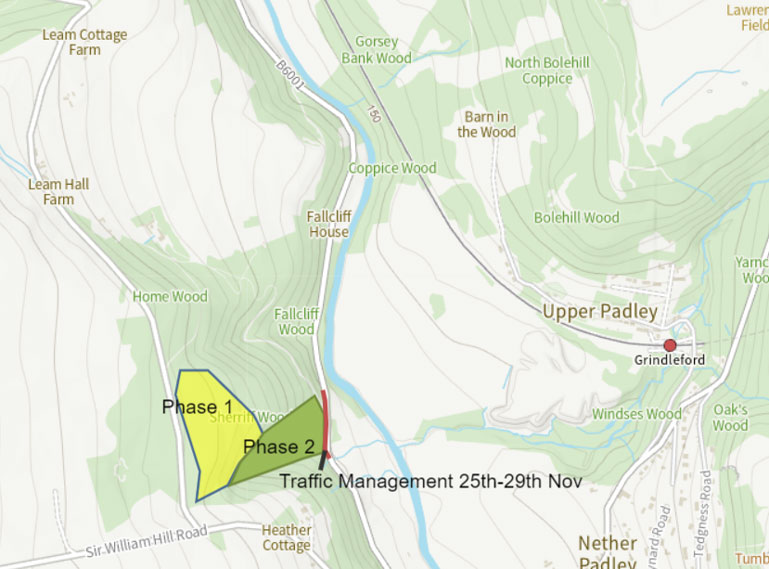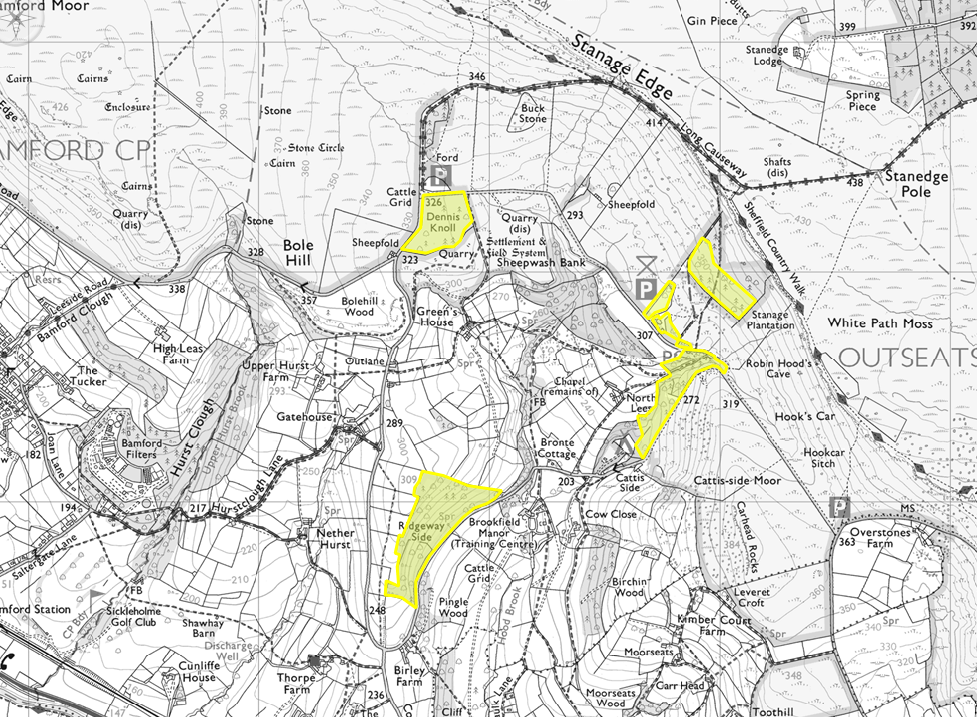FAQs - Larch Disease and Woodland Restoration

Tree felling for larch disease control and woodland restoration
A number of areas of woodland in the Peak District National Park have been confirmed to have an infection of Phytophthora ramorum (P.ramorum) or 'larch diease'. Areas affected may be served with a Statutory Plant Health Notice (SPHN) by Forestry England which requires, by law, that the landowner takes appropriate action to fell and remove any trees impact by the outbreak and minimise likely future spread.
As a result, you may find areas of woodland or adjacent rights of way are closed while these works take place. Please follow all signage as instructed both for your own safety whilst heavy equipment may be operating unseen, and also to minimise further spread of the disease.
At each location the landowner is responsible for works under the SPHN, and this may not be the Peak District National Park Authority.
What is Phytophthora ramorum?
Phytophthora ramorum (P.ramorum) is a form of water mould which affects both the foliage and bark of infected trees causing cankers (lesions which exude fluid). This infection can lead to the gradual death of branches and needles/leaves of infected trees, with the tree dying once the lesions become extensive on the main trunk.
P.ramorum affects over 150 different species of plants. Larch trees are highly susceptible to the disease and have been badly infected in some of our woodlands alongside sweet chestnut trees and Rhododendron. Sycamore and beech trees are also susceptible to the disease, but are likely to recover once any infected larch and sweet chestnut trees have been removed.
To find out more about P.ramorum, visit: Forest Research. If you spot any of these symptoms on trees while you are out and about, report them here: TreeAlert
Further FAQs are shown below.
Leam Woods, near Grindleford - Woodland Restoration
Landowner: Peak District National Park Authority
UPDATE: Due to suitable conditions and contractor availability, we are proceeding with Phase 2 of the felling works this year (instead of next year) in order to reduce disruption by completing all felling works in one operation.
As part of these works, we will be undertaking roadside tree safety works along the B6001, which will be undertaken under a one-lane closure with temporary traffic lights in operation between Monday 25 November and Friday 29 November, between the hours of 9am and 4pm.
Occasional two-way traffic management may be required to undertake the works and therefore traffic delays may be possible.

What's happening?
The National Park Authority is undertaking tree felling works in this woodland during October and November 2024 to halt the ecological decline of the woodland and try to restore the woodland to native oak/birch. This is a long-term project, the first phase of which is to reduce the amount of planted, non-native conifers in the woodland (typically Larch) and open up areas to favour the struggling remnants of Ancient Semi-Natural woodland still present underneath the conifer plantation areas.
Why are trees being felled?
Removing the non-native conifers improves conditions for native species – both trees, flora and wildlife - to thrive and recover.
Historically the woodland at Leam would have been Upland Oak-Birch Ancient Semi-natural Woodland, but parts of the woodland were cleared and replanted with commercial, non-native conifer species, such as larch, fir and western hemlock, during the 1880s, 1940s and 1950s. The majority of the woodland is now a Planted Ancient Woodland Site (PAWS). This means the woodland has remnant features of what used to be there, such as occasional oak trees and ground flora associated with Ancient Semi-Natural Woodland, but generally the site has low biodiversity and some parts of it are in a critical state in need of urgent action to halt the decline of ancient woodland remnants on the site.
As well as being a site in decline in terms of species diversity, the woodland is also at high risk of being infected with a disease called Phytophthora ramorum (P. ramorum), due to the presence of Larch in the woodland and the high level of P. ramorum infection within a 5-mile radius of the woodland. Larch trees and sweet chestnut trees are particularly susceptible to P. ramorum. By removing the larch, we aim to reduce the risk of infection with P. ramorum and therefore reduce the risk of sweet chestnut trees in the woodland and surrounding area being infected and requiring removal.
In order to avoid infection with P. ramorum, and in order to restore the woodland to native broadleaf species, we are planning to fell and extract all larch trees from the woodland over the next two years. We aim to retain all other species on site, where it is safe to do so and where they pose no risk of windthrow on to the public highway.
The felling works will change the look and feel of the woodlands, but these operations help us to manage woodlands in a sustainable way to produce timber, to reduce the risk and spread of disease and to enable the woodland to become more biodiverse, resilient and ecologically sustainable in the long-term, contributing to nature recovery across the valley.
What will happen next?
All felled areas will be replanted with native broadleaf species already present on the site, including oak, birch, hazel, holly, rowan, cherry and hawthorn.
Stanage Plantation and other woodlands on the Stanage-North Lees estate
Landowner: Peak District National Park Authority
In April 2021, the presence of Phytophthora ramorum, a highly infectious plant disease, was confirmed in woodlands on the North Lees Estate, including Stanage Plantation. In January 2022, the presence of P. ramorum was confirmed in more woodlands on the North Lees Estate, including Dennis Knoll Plantation, Tain Wood and Ridgeway Side.
The map below shows the areas of woodland which have been confirmed to be infected with P.ramorum (yellow).

Why have trees been felled?
The Forestry Commission issued a Statutory Plant Health Notice (SPHN) for areas of our woodland which are infected with P.ramorum (see map above). This legally requires us (the owners of the woodland) to fell all the larch and sweet chestnut trees within these areas.
These trees are cut down and removed to help prevent the further spread of the disease to other areas of woodland on the estate and in neighbouring woodlands.
Cutting down diseased and highly susceptible species such as larch helps to protect other areas of woodland which could be infected. We will be removing the infected timber from site and will be restoring and enhancing the site through natural regeneration and re-planting.
What happens next?
Felling and extraction operations have been carried out sensitively to avoid damage to the surrounding SSSI and archaeological features. Extraction routes have been chosen carefully to avoid designated features.
We will be working closely with our Landscape and Ecology teams to manage the re-stocking of any felled areas through natural regeneration and re-planting with a mixture of broadleaf species, including oak, birch, alder and rowan.
We will be undertaking vegetation enhancement along extraction routes. Part of his will involve spreading heather brash sourced from the moorlands above, containing heather seed, along the extraction route. The seed will hopefully establish where bracken beds have been disturbed. In the future, bracken control will be targeted in areas where heather re-establishes.
Even though the felling of infected areas will change the feel and look of our woodlands, this is an opportunity for us to look at how we can help to make our woodlands resilient to other tree pests and diseases and other pressures such as climate change.
Why are trees being cut down in some parts of the National Park?
Forestry experts have identified an outbreak of the tree disease Phytophthora Ramorum in areas of the Peak District including the Goyt Valley and Stanage North Lees estate, affecting large numbers of larch (Larix species) trees and a smaller number of Sweet Chestnut (Castanea sativa). As a result of the discovery of the disease, a Statutory Plant Notice now places a legal obligation on the respective landowner(s) to complete work to fell infected trees in the affected area.
Why do the trees need to be cut down/can't they be treated?
Felling is the only effective way to prevent further spread of the disease, and stop it killing other trees and plants in the affected area. Infection occurs through spores dispersed in moisture, including moist air currents so it is essential that affected trees are removed to prevent the spread.
What will happen?
Infected trees will be felled by approved contractors, and removed from the area. Spraying and follow-up felling may continue until 2024.
Will other trees be affected by the works?
Some adjacent tree specimens may need to be removed to allow access to safely fell the affected larch trees, as the removal of larch may leave remaining trees (such as pines) too exposed and susceptible to damage. A small number of infected veteran sweet chestnut trees will be pruned by tree surgeons where applicable to remove the affected branches but retain these valuable trees.
Will the areas affected be re-planted?
The areas affected will be re-planted with tree species that are resilient to the disease to ensure the future of the respective woodlands for generations to come. The felled trees will be used where possible as construction timber, fencing materials, pallet wood and biomass.
The areas affected will be re-planted with tree species that are resilient to the disease to ensure the future of the respective woodlands for generations to come.
Re-planting at Stanage-North Lees is being funded by the Peak District National Park Foundation thanks to generous donations and the fundraising efforts of Peak Running - Run for the Birds. To support more work like this you can donate.
Will any access be restricted?
Rights of way or car park areas used for heavy plant may be temporarily closed when works are underway for public safety, and visitors are urged to observe all diversions or closures.
Route closures will be notified and supported by on-site signage.
What about the future landscape?
Forestry England will be working with the National Park Authority to ensure valuable features including wildlife and archaeology are impacted as little as possible by these necessary works. We will also support the plans to re-plant the woodland and ensure it remains representative and complimentary to the Peak District landscape of the area.
What is Phytophora?
P Ramorum is a non-native, fungus-like organism first discovered in the UK in 2002. It causes disease on trees, shrubs and plants in woodland, heathland, gardens and nurseries. As a form of water mould P. Ramorum affects both the foliage and bark of infected trees causing cankers (lesions which exude fluid). This infection can lead to the gradual death of branches and needles/leaves of infected trees, with the tree dying once the lesions become extensive on the main trunk.
P.ramorum affects over 150 different species of plants. Larch trees are highly susceptible to the disease and have been badly infected in some of our woodlands alongside sweet chestnut trees and Rhododendron. Sycamore and beech trees are also susceptible to the disease, but are likely to recover once any infected larch and sweet chestnut trees have been removed.
To find out more about P.ramorum, visit: Forest Research. If you spot any of these symptoms on trees while you are out and about, report them here: TreeAlert
Can I help stop the spread of Phytophora?
Phytophthora Ramorum ‘Larch disease’ is a plant pathogen and is harmless to people and animals. You can help reduce its impact in the countryside through the following actions:
- Clean soil and mud from boots, shoes and bike tyres before leaving woodland
- Thoroughly wash boots/shoes/tyres (preferably with disinfectant) before visiting other areas
- Keep to marked paths
- Keep dogs on leads
- Do not remove plant material from woodlands
Last updated: October 2024

